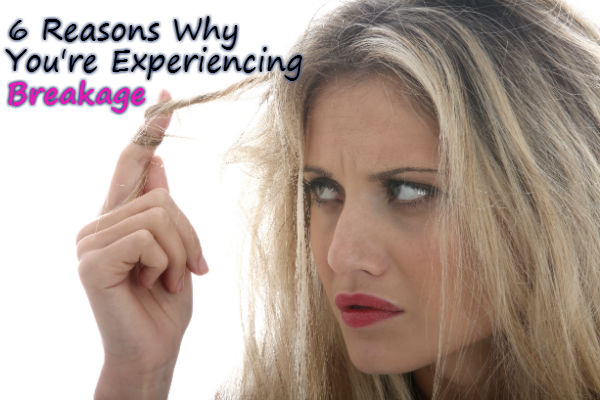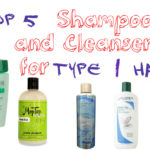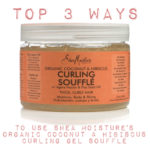
Hello Lovelies! Nothing will cut your long hair dreams faster than breakage. The bad news about breakage is that it is most likely caused by your own actions. The good news is that since most breakage is caused by our own damaging techniques and lack of care, our breakage problems can be solved! Isn’t that great? Stress is at the root of all hair breakage. No, not the biological reaction to emotional challenges that is commonly known as “stress.” Nevertheless, that kind of stress can cause hair loss, but that’s usually hair loss in the form of shedding, which is completely different from breakage, but I’ll explain that in another post. The type of stress or stressors that causes hair to break are external stressors. When these external stressors become too much for our hair to handle, it breaks off at points where the damage is most severe. So in order to stop breakage, you must stop, or at best block, the external stressors that are causing acute damage to your hair. Read on to find out the six types of stress that causes severe hair breakage, and find out the solutions to stop the damage dead in its tracks.
Over-manipulation
A tug here, a twirl there, why can’t we seem to keep our hands out of our hair? This is what I like to call “hand in head” syndrome. Styling or playing in your hair any more than necessary is called over-manipulation. Those style changes and hair twirls may seem innocent, but in actuality, they’re perhaps one of the leading causes of hair breakage. Why? Well over-manipulation is cumulative. For instance, let’s say you redo your ponytail everyday in the same spot, with the same hair tie, because you know, what girl wouldn’t want her pony looking fabulous and neat everyday? Well, overtime, you may experience breakage around the perimeter of your head and in the crown of your head where you place your ponytail. This is happening because you’re constantly manipulating the same sections of your hair everyday. If you rubbed the same spot of carpet on your floor every day, you’d eventually notice a bald spot in that area because you wore away the fibers. The same thing is happening when you over-manipulate your hair. Even the friction of rubbing your hair against a cotton pillow as you sleep can be damaging to your hair overtime.
The Solution:
The best way to prevent over-manipulation is to wear your hair in protective styles. These styles beat over-manipulation and breakage in two ways. One, it protects your hair from yourself, because if it’s tucked away, you don’t have as much access to tug and twirl it. Secondly, it protects your hair from friction and other stressors that are known to cause breakage. If you choose to wear the same style over and over again, such as a ponytail, simply change up where you place the ponytail every now and then. Perhaps rock a high ponytail for a few weeks, then rock a low one for the next couple of weeks. This way you aren’t placing stress on the same sections of hair. Additionally, sleeping on a silk or satin pillow will protect your hair from friction that could cause breakage over time.
Heat Damage
It’s fun to change our hair hair texture and try different styles with heating tools like flat irons, curlers, and blow dryers. However, too much heat and using heat too often is perhaps one of the quickest ways to damage your hair and cause breakage. When you heat your hair beyond a certain point, the hair’s cuticle, which functions as a protective layer, lifts from the rest of the hair shaft. When this happens, it’s hard for the hair to hold in moisture, which eventually leads to dry and brittle hair. Dry and brittle hair is more prone to breakage and irreversible damage in the form of split ends. In curlier hair textures, heat damage can not only cause breakage, but it can permanently alter the hair texture.
The Solution:
To avoid heat damage the solution is simple–turn down the heat. Use an appropriate heat setting according to your hair type whenever you plan to use heating tools. Always apply a heat protectant spray or cream to your hair prior to using heat tools to protect the hair from burning. Or better yet, give the heat tools a rest. Instead of straightening or curling your hair, wear hairstyles in your natural texture that don’t require any heat tools to completely eliminate the possibility of heat damage.
Chemical Overlapping
Dying our hair different fun and funky colors and applying chemical straighteners make for fun and attractive hair changes, but improper application of these products could cause severe damage to your hair. Sure, no one wants visible roots to throw off their fabulous dye job, but overlapping hair color, relaxers, bleach, and even keratin treatments can swell the hair cuticle beyond resiliency. Additionally, overlapping chemical processes can wear down the very thing that makes our hair strong–protein bonds.
The Solution:
If you don’t want to forego chemical processes on your long hair journey, at the very least, keep them to a minimum. That may mean stretching your relaxers or faking the new ombre hair trend as your dye job grows out. If you chemically treat your hair while you’re growing it out, regular protein treatments are an absolute must. Regular protein treatments will keep your hair strong by ensuring that the cuticle and the protein bonds in the hair shaft remain intact.
Sun/UV Damage
We all know that UV rays from the sun can be damaging to our skin, but it turns out that UV rays from the sun can be equally as damaging for our hair. Have you ever noticed your hair change colors after spending an extended period of time in the sun? Well, that’s a clear sign you’ve sustained some damage from the sun’s rays. UV rays from the sun break down the protein bonds found in the hair shaft. The damage caused by UV rays can be even harsher on chemically treated hair; this is why color-treated hair becomes brassy during the summer time if you don’t provide adequate protection.
The Solution:
Similar to how we protect our skin from the sun’s rays with sunscreen, we need to protect our hair from the harsh rays of the sun with an equivalent product. There are tons of sunscreen sprays and creams
for the hair that should be applied prior to spending time out in the sun. At the very least, wear a hat
or adorn your tresses with a light and fashionable head scarf as a protective barrier from the sun’s harmful rays.
Environmental Damage
From hard water to wind, several environmental elements can cause damage and breakage to your hair. The winter is perhaps the number one time our hair is most susceptible to damage because the air is dryer and the winds are typically higher. Now most of us don’t have the ability to stop something like the wind (and if you can, maybe Captain Planet should recruit you for his team), but what we can do is protect our hair from environmental that we otherwise can do nothing about.
The Solution:
When it comes to certain environmental elements, the best you can do is to hide your hair from their harsh conditions. This may mean wearing your hair in bun when it’s windy to prevent the friction of the wind from drying and damaging your hair. If you suspect you have hard water, you can remedy the problem with a water filter for your shower.
Hygral Fatigue
Have you ever stretched a scrunchy or something else “stretchy” over and over and over again? Well, what happens? It eventually loses its strength, right? Sometimes to the point where it won’t go back to it’s original shape. Well that’s what happens to certain types of hair when you wash it too much, and it’s called hygral fatigue. The constant swelling and deswelling of the hair when you wash it too often chips away at the hair’s cuticle and protein bonds, which can cause moisture loss and dry, brittle, weakened hair. Now hygral fatigue doesn’t happen to everyone because every head of hair isn’t the same. Some people can get away with and even benefit from washing their hair frequently while others cannot. Nevertheless, if you suspect hygral fatigue is happening to you, there are a two ways you can stop it in it’s tracks.
The Solution:
The simplest way to stop or hygral fatigue is to simply not wash your hair as often as your normally would. If you want to remove excess oil and buildup from your scalp in between washes, try a dry shampoo. If you absolutely must stick to your current hair washing schedule due to your level of activity or for other reasons, try pre-pooing your hair with certain oils to keep water from excessively swelling the hair shaft during cleansing sessions.


